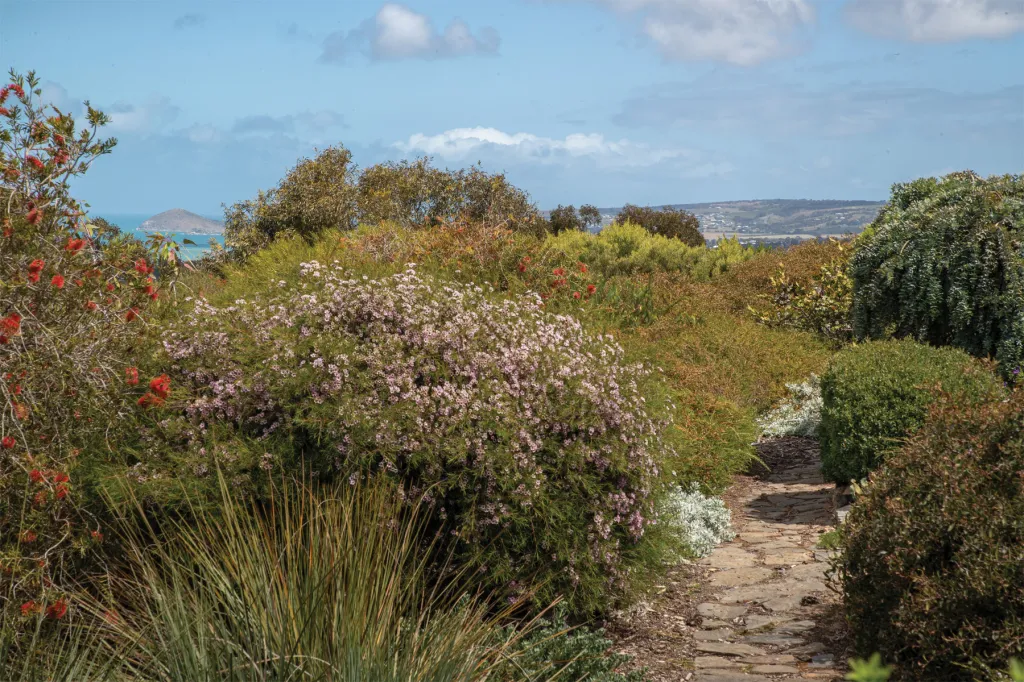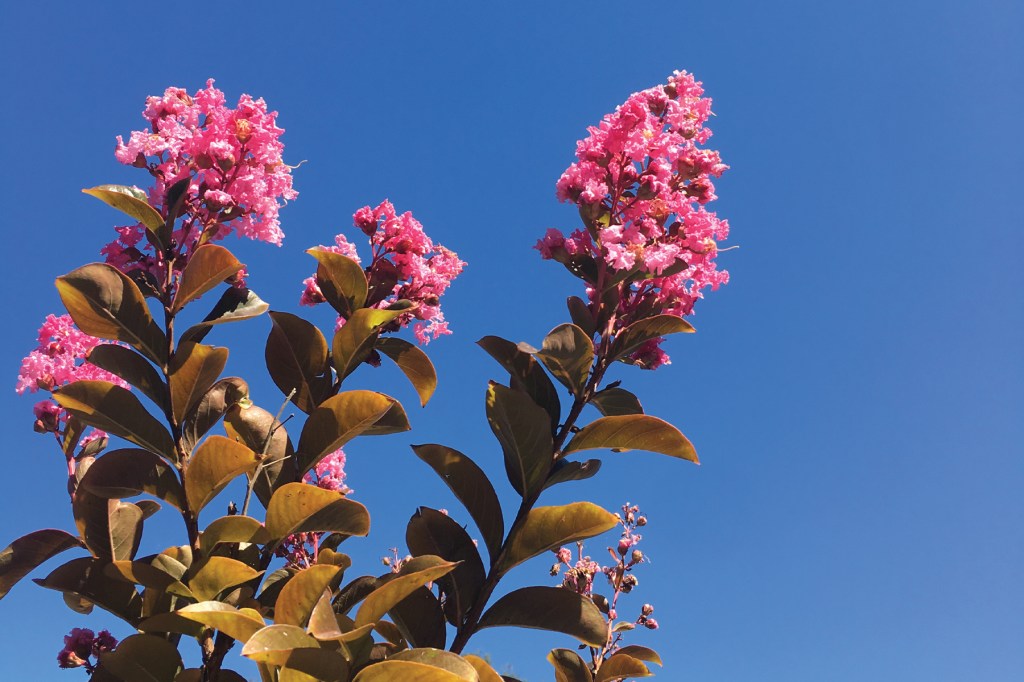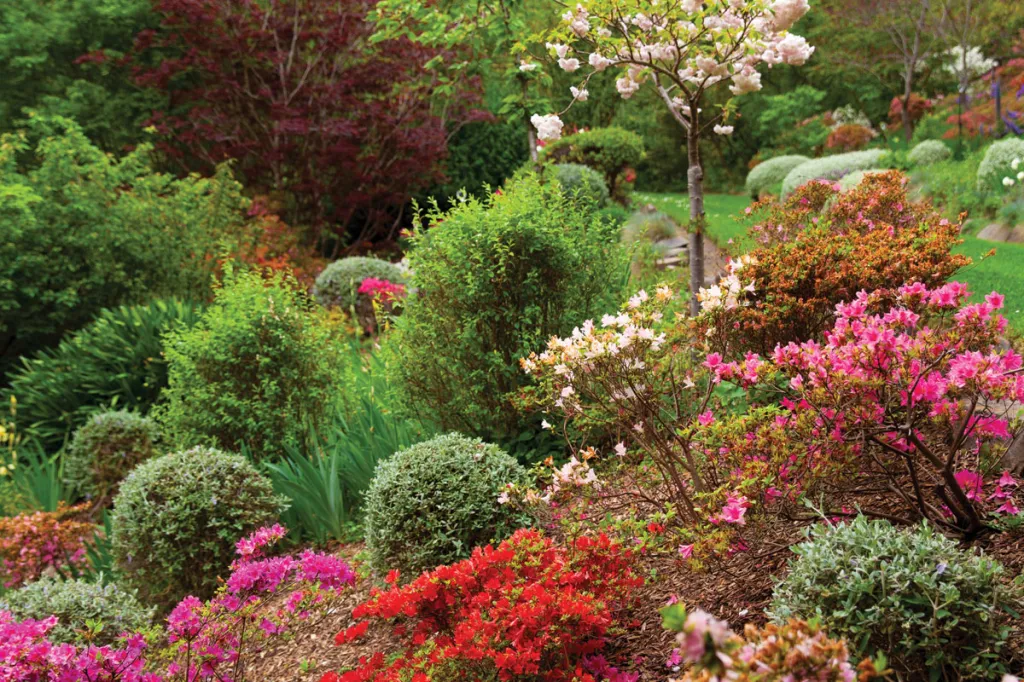Take me home, country roads
Twenty years ago, this breathtaking Port Elliot native garden was little more than a cow paddock. But with much hard work and determination, Judy and Andrew Baghurst have transformed the area into a sanctuary for local fauna. SALIFE Gardens & Outdoor Living recently toured the garden ahead of the release of Judy’s book, Down the Garden Path, documenting the process.

Judy Baghurst developed her passion for native flora at an early age. As a child, she remembers wandering around the bush while on family holidays in the state’s South East, admiring the bright gold hibbertias, purple tetrathecas and other wildflowers.
“I found their intricacy particularly lovely – their fine foliage – and I found it amazing that these flowers grew uncared for,” says Judy, a retired school teacher.
This love of native plants stayed with Judy as she grew up and it’s a love now also shared by her husband Andrew, an electrical engineer.
Over the past 20 years, the couple has created a native paradise on their Port Elliot property. The garden first appeared in the pages of SALIFE nearly 15 years ago, when it was awarded the Best Home Garden award at the 2009 Sustainable Landscapes Native Gardens competition. Since then, it has also been featured on ABC-TV’s Gardening Australia, while an open garden once attracted some 1400 people to the property.
SALIFE Gardens & Outdoor Living recently re-visited Port Elliot ahead of the release of Judy’s new book titled Down the Garden Path.
Alongside documenting the process of creating their oasis, the book includes many poems written by Judy as an ode to her patch.
“It’s lovely to have recorded its maturing over that period, particularly its best seasons, and to have something to look back on,” Judy says.
The garden now boasts thousands of native trees and plants, ranging from black sheoaks (Allocasuarina verticillata) to pink gum (Eucalyptus faciculosa), dryland black paperback (Melaleuca lanceolata), mallee honeymyrtle (Melaleuca-acuminata), muntries (Kunzea pomifera), Eremophilas, silver cushion bush (Leucophyta brownii), dwarf Hakea (Hakea rugosa), Hakea ‘Burrendong Beauty’, red pokers (Hakea bucculenta) and desert flame (Chrysocephalum apiculatum).
Before they moved to Port Elliot, Judy and Andrew lived in Eden Hills, where they grew native trees for Trees for Life.
Judy says it was always sad to watch the seedlings leave for the Trees for Life farm, where they were planted at the end of the season.
“I thought, wouldn’t it be nice if we had a place where we could grow the seedlings and then plant them and watch them develop into trees,” she says.
And so, when a large block came on the market above Port Elliot in 1994, Judy and Andrew decided to take up the challenge of revegetating the land.
“We bought four or five acres and were astounded; we put in about 1600 trees and shrubs over two or three years and they all grew with only half a bucket of water put on when they were first planted – it was amazing.”

Grevilleas such as Coconut Ice, Grevillea lanigera Mount Tamboritha and Leucophyta brownii huddle together in the garden.
When an adjoining 21-hectare block became available in 1997, Judy and Andrew initially hesitated since it could not be subdivided, meaning it would be a much larger project than they anticipated. But with idyllic views from Victor Harbor to Middleton, it was the perfect location for their home, built in 2001 to maximise views of the surrounding nature.
“When the big 21-hectare block came up for sale, we loved the flat plateau area between the hills – a perfect place for a holiday house, we thought at the time. There was certainly plenty of room to plant forever,” says Judy.
"I had the joy of seeing things grow and flourish and flower and the disappointment of seeing some fail, of course, but that’s gardening everywhere and it never turns out exactly as you expect"
They sold their original four-acre block in Port Elliot and embarked on a new challenge.
The land had previously been used for cattle grazing but had become overgrown with woody weeds such as blackberries, briar rose and olives. The only native plants to be found were golden wattle (Acacia pycnantha), sticky wattle (Acacia dodonaeifolia), kangaroo thorn (Acacia paradoxa), wallowa (Acacia calamifolia), gold dust wattle (Acacia acinacea) and coast flax lily (Dianella brevicaulis).
“We were intimidated because there was only one eucalypt and three sheoaks – they were the sum total of native trees on the property,” she says. “There were lots of rubbishy plants we had to get rid of – we were a bit nervous about that.”

The house faces magnetic south with the rough “Tank Track” just visible, leading from the shed to the three original water tanks.

In this picture, taken in 2022, the Tank Track clearly defines the southern boundary of the garden. Plantings in the outer areas merge seamlessly into the revegetation. Previous pages Judy Baghurst laid the first stone path on their property from March to July 2002. It now brims with pink Geraldton Wax (Chamelaucium uncinatum).
With the help of a local company, they set about clearing the property, planting around 5000 tree seedlings in 1998. One of the first species Judy and Andrew planted was Eucalyptus leucoxylon, commonly known as South Australia blue gum. Evidence showed that blue gums once lined a nearby gully, but bushfires in 1939 and 1942 wiped the trees out and local farmers preferred not to replace them.
Judy and Andrew enlisted Alan Fisher from Gardens Australis to design the garden in the early 2000s, which was formed around circles, semi-circles and curving beds surrounded by cut grass. A local landscape gardener prepared the ground, fighting through the weeds, marking sections planned for garden beds, using a tractor to loosen the soil and helping to choose plants for the garden.
Subscribe for updates

(Left) Scarlet kunzea (Kunzea baxteri) is one of a variety of kunzea shrubs that grow in the garden. (Right) Acacia dodonaeifolia was growing wild on the property when Judy and Andrew purchased it.
Despite some initial assistance, Judy has done most of the gardening herself, with Andrew mowing the lawns and helping with hard digging.
“The actual garden has been a big retirement project for me and I have learnt so much about native plants in the process,” says Judy. “I had the joy of seeing things grow and flourish and flower and the disappointment of seeing some fail, of course, but that’s gardening everywhere and it never turns out exactly as you expect.”

Red-browed finches were among the first little birds to appear in the garden when Judy and Andrew began revegetating it.
Judy says there was a lot of trial and error working out which plants grow well in the rocky, heavy soil. She has gained tips by visiting conservation parks, reading gardening books, asking for advice at the State Flora Nursery and liaising with other owners of large native gardens. Judy says the garden took around a decade to fully establish and that since SALIFE’s initial visit to the property, the garden has thickened and matured.
“Initially the wind was such as to keep things pruned at almost the same height but gradually a few plants were brave enough to stick their heads up above the others,” she says.
"One of the main goals in revegetation was not just to create something pretty, but to establish a habitat that wild creatures could come back to"
This, alongside the bluestone rock scattered throughout the garden and the unreliable rainfall, is one of the biggest challenges.
Judy says that her favourite part of the garden is the outlook from their dining room, with its view of the layered garden featuring plants such as Thomasia purpurea, yellow paper daisies and Eremophila calorhabdos, as well as a postcard view of Middleton.

The sundial, a centrepiece of the garden, is dedicated to Judy and Andrew’s parents. It was created by two retired physicists and comes within two minutes of standard time. In the foreground is Grevillea Coconut Ice, with Grevillea thelemanniana and silver-grey Leucophyta brownii behind it.

Outside the kitchen window is a pond, lined with a rubber covering and carefully fitted with rocks, which attracts frogs after it rains.
But apart from creating an attractive garden, for Judy and Andrew, one of the main priorities has always been to revegetate the area and create a habitat for local wildlife. This habitat now provides refuge for native fauna, including around two dozen kangaroos, echidnas, red-bellied, black and brown snakes, blue tongue and sleepy lizards, Horsfield’s bronze cuckoos, wedge-tailed eagles, magpies, New Holland Honeyeaters, topknot pigeons, blue wrens, yellow-rumped thornbills, and red-browned finches.
“One of the main goals in revegetation was not just to create something pretty, but to establish a habitat that wild creatures could come back to because they’ve had so much taken away from them with housing developments and so on,” Judy says.
“And, of course, we wanted local species that would be comfortable and really grow here, partly to help ameliorate climate change as well as provide habitat and so on.”
To enquire about the book contact Judy at [email protected].
This article first appeared in the Summer 2024 issue of SALIFE Gardens & Outdoor Living magazine.

